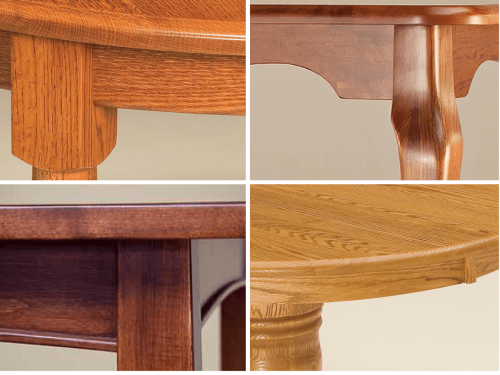Aprons and Skirts on Amish Dining Tables
By Holly Rennels · January 28, 2016
How to Choose the Right Table Apron
Hardwood Aprons or Skirting on Tables & Chairs
An apron, also called the "skirt" or "skirting", is simply the portion of the table or chair that is vertically positioned beneath the table top or seat. This hides any corner blocks, bracing, self-storing, or other mechanical pieces (on tables) from plain view. Aprons are typically 1 1/2"-3" and add character to the piece of furniture.
When ordering an Amish handcrafted table, you should know that each table is a custom, made-to-order piece that will last your family for generations. At Countryside, once you have selected a base table, we ask you to begin by deciding which hardwood will be formed into the centerpiece of your dining room or eat-in kitchen. Your second decision relates to the size and expantion potential you require in a table. In many cases you will be able to choose from various edges, shapes, legs, and base options to design a truly custom table for your home. Finally, stain selection is a challenge, but we offer free samples to ensure you can choose wisely.
Most of our dining room tables do not offer apron options, but we do frequently make custom adjustments to this important element. We use the terms "apron" and "skirt" interchangeably and here you will find the definition and purpose of a table apron. In some cases, a table will be offered without an apron of any kind. Below please find a bit of an apron tutorial to help you navigate terms and looks you may encounter when personalizing your dinner table.
Straight Apron
To review, the apron of the table is the piece beneath the table top's edge. A very common apron style is the straight apron. This apron is used in Arts and Crafts, Mission, Shaker, and Contemporary furniture and provides a crisp, clean line.
Steam Bent Rounded Apron
When a table or chair is round, the apron is steam bent to curve accordingly, but is one solid piece of wood. On round or oval dining tables, it is common to have an unadorned edge. Wood for the apron is then bent with steam and shaped to accommodate the table top.
Scalloped Formal Table Apron
Queen Anne Style requires a bit more from a dining table apron and the scalloped shape is common. The detail can vary in that some are quite ornate and include routing or beading, but this apron is definitely for a more Traditional, formal dining room set.
Cut Out Table Apron
Perfect for French Country Dining Tables, the cut out apron is less fussy than a scallop, but still offers visual interest. This apron can also be found in Contemporary and Transitional dining tables.
No Apron
Live edge, plank top, and some Modern dining tables will not apply an apron at all. This means that self-storing leaf options may be limited and/or visible. Adding a butterfly leaf to a table with a small or absent apron may also be a bad idea as the mechanics of the leaf will be visible to diners. Otherwise, the ultra Contemporary look that can be created by eliminating the apron can be very appealing as a crisp line and the anatomy of the table becomes more apparent.
Beaded Apron
Any apron can have a beaded edge applied. The lower detail of the apron has been carefully routed for a formal look. This apron happens to be a slightly arching edge, which is technically still a "straight edge" since the arch is gradual and not a carving or cut out. Beading does add visual interest and is most common in Traditional, Queen Anne, and French Country dining tables.
Aprons can be scalloped, carved, or curved in a variety of ways. The purpose is to create a barrier between the mechanics of the table or chair and the aesthetic beauty. On occasion, a specialty apron will emerge to create an angle or element of visual interest that falls outside of the skirting options oultined here. In these instances, there will likely not be an option to alter the apron. Understanding the details of your Amish made dining or kitchen table will help you further appreciate the beauty and craftsmanship of our fine furniture. If you have any questions about table aprons or anything else, feel free to contact us by chat, e-mail, social media, or phone.

